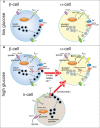Glucagon secretion and signaling in the development of diabetes
- PMID: 22969729
- PMCID: PMC3432929
- DOI: 10.3389/fphys.2012.00349
Glucagon secretion and signaling in the development of diabetes
Abstract
Normal release of glucagon from pancreatic islet α-cells promotes glucose mobilization, which counteracts the hypoglycemic actions of insulin, thereby ensuring glucose homeostasis. In treatment of diabetes aimed at rigorously reducing hyperglycemia to avoid chronic complications, the resulting hypoglycemia triggering glucagon release from α-cells is frequently impaired, with ensuing hypoglycemic complications. This review integrates the physiology of glucagon secretion regulating glucose homeostasis in vivo to single α-cell signaling, and how both become perturbed in diabetes. α-cells within the social milieu of the islet micro-organ are regulated not only by intrinsic signaling events but also by paracrine regulation, particularly by adjacent insulin-secreting β-cells and somatostatin-secreting δ-cells. We discuss the intrinsic α-cell signaling events, including glucose sensing and ion channel regulation leading to glucagon secretion. We then discuss the complex crosstalk between the islet cells and the breakdown of this crosstalk in diabetes contributing to the dysregulated glucagon secretion. Whereas, there are many secretory products released by β- and δ-cells that become deficient or excess in diabetes, we discuss the major ones, including the better known insulin and lesser known somatostatin, which act as putative paracrine on/off switches that very finely regulate α-cell secretory responses in health and diabetes. Of note in several type 1 diabetes (T1D) rodent models, blockade of excess somatostatin actions on α-cell could normalize glucagon secretion sufficient to attain normoglycemia in response to hypoglycemic assaults. There has been slow progress in fully elucidating the pathophysiology of the α-cell in diabetes because of the small number of α-cells within an islet and the islet mass becomes severely reduced and inflamed in diabetes. These limitations are just now being surmounted by new approaches.
Keywords: diabetes; glucagon secretion; hypoglycemia; islet α-cell; somatostatin.
Figures



Similar articles
-
Inhibition of glucagon secretion.Adv Pharmacol. 2005;52:151-71. doi: 10.1016/S1054-3589(05)52008-8. Adv Pharmacol. 2005. PMID: 16492545 Review.
-
Paracrine regulation of glucagon secretion: the β/α/δ model.Am J Physiol Endocrinol Metab. 2016 Apr 15;310(8):E597-E611. doi: 10.1152/ajpendo.00415.2015. Epub 2016 Feb 2. Am J Physiol Endocrinol Metab. 2016. PMID: 26837808 Free PMC article.
-
δ-Cells: The Neighborhood Watch in the Islet Community.Biology (Basel). 2021 Jan 21;10(2):74. doi: 10.3390/biology10020074. Biology (Basel). 2021. PMID: 33494193 Free PMC article. Review.
-
The Role of α-Cells in Islet Function and Glucose Homeostasis in Health and Type 2 Diabetes.J Mol Biol. 2020 Mar 6;432(5):1367-1394. doi: 10.1016/j.jmb.2020.01.004. Epub 2020 Jan 15. J Mol Biol. 2020. PMID: 31954131 Review.
-
Pharmacologic inhibition of somatostatin receptor 2 to restore glucagon counterregulation in diabetes.Front Pharmacol. 2024 Jan 17;14:1295639. doi: 10.3389/fphar.2023.1295639. eCollection 2023. Front Pharmacol. 2024. PMID: 38298268 Free PMC article. Review.
Cited by
-
Modeling Type 1 Diabetes Using Pluripotent Stem Cell Technology.Front Endocrinol (Lausanne). 2021 Apr 1;12:635662. doi: 10.3389/fendo.2021.635662. eCollection 2021. Front Endocrinol (Lausanne). 2021. PMID: 33868170 Free PMC article. Review.
-
Islet β cell mass in diabetes and how it relates to function, birth, and death.Ann N Y Acad Sci. 2013 Apr;1281(1):92-105. doi: 10.1111/nyas.12031. Epub 2013 Jan 30. Ann N Y Acad Sci. 2013. PMID: 23363033 Free PMC article. Review.
-
SIRT1 activation attenuates α cell hyperplasia, hyperglucagonaemia and hyperglycaemia in STZ-diabetic mice.Sci Rep. 2018 Sep 18;8(1):13972. doi: 10.1038/s41598-018-32351-z. Sci Rep. 2018. PMID: 30228292 Free PMC article.
-
Possible contribution of taurine to distorted glucagon secretion in intra-islet insulin deficiency: a metabolome analysis using a novel α-cell model of insulin-deficient diabetes.PLoS One. 2014 Nov 13;9(11):e113254. doi: 10.1371/journal.pone.0113254. eCollection 2014. PLoS One. 2014. PMID: 25393115 Free PMC article.
-
An extended minimal model of OGTT: estimation of α- and β-cell dysfunction, insulin resistance, and the incretin effect.Am J Physiol Endocrinol Metab. 2024 Feb 1;326(2):E182-E205. doi: 10.1152/ajpendo.00278.2023. Epub 2023 Dec 13. Am J Physiol Endocrinol Metab. 2024. PMID: 38088864 Free PMC article.
References
-
- Amatruda J., Livingston J. (2003). Glucagon, in, Ellenberg and Rifkin's Diabetes Mellitus, eds Porte D., Jr., Sherwin R., Baron A. (New York, NY: McGraw-Hill; ), 97–115
LinkOut - more resources
Full Text Sources

